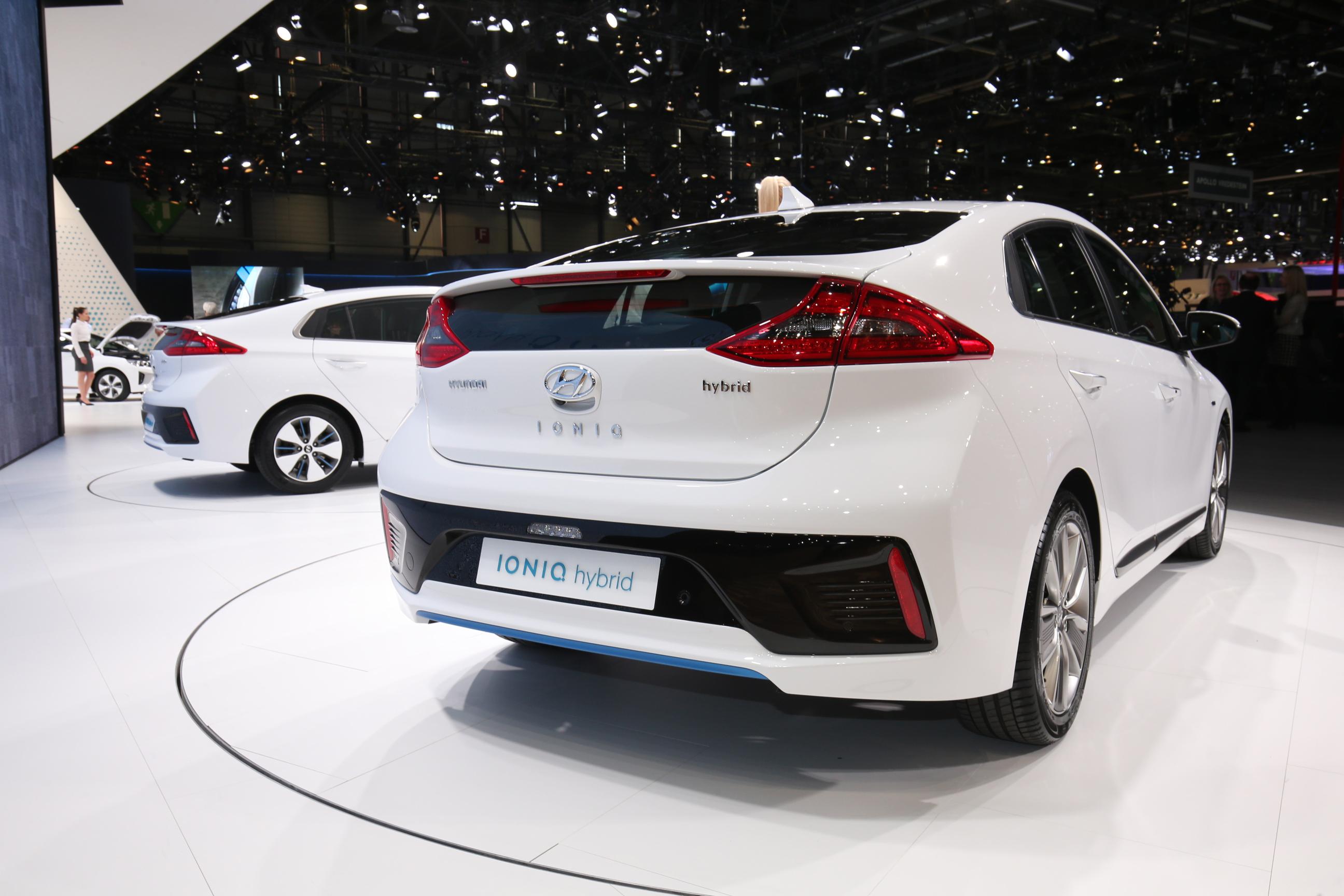
At a Glance – the All-New Hyundai IONIQ ELECTRIC
- World’s first vehicle platform with three electrified powertrains, making low- to zero-emission mobility accessible to everyone
- Innovative IONIQ offers customers uncompromised driving experience and design
- Latest connectivity and active safety features enhance IONIQ’s efficient package
2017 HYUNDAI IONIQ ELECTRIC PRICING
| Model | Engine | Transmission | Drivetrain | MSRP |
| Electric | 88kW Electric Motor | Single-speed Reduction Gear | FWD | $29,500 |
| Limited | 88kW Electric Motor | Single-speed Reduction Gear | FWD | $32,500 |
Freight Charges for the 2017MY Ioniq Electric are $835.
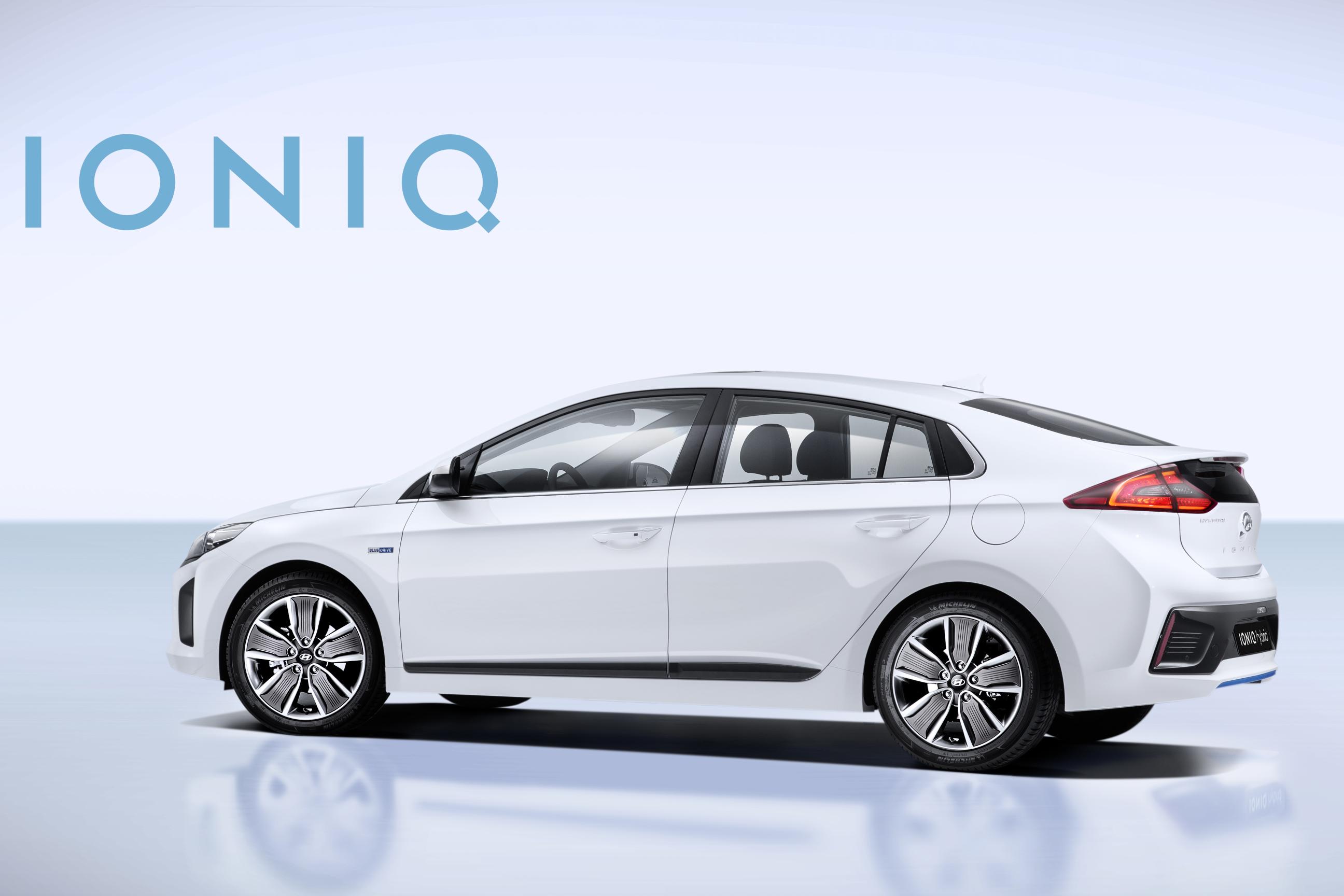
At the 2016 Geneva Motor Show, Hyundai Motor is introducing the All-New Hyundai IONIQ line-up, consisting of: IONIQ Hybrid, IONIQ Electric and IONIQ Plug-in. The world’s first model offering three electrified powertrains, IONIQ will make low- to zero-emission mobility accessible to everyone. The new approach of Hyundai Motor delivers an uncompromising design and driving experience through innovative technology and offers customers the latest connectivity and safety technologies.
The All-New Hyundai IONIQ is an important milestone in Hyundai Motor’s sustainability strategy, bringing to life the brand’s new thinking through new innovative technologies and extending the company’s product range to support further organic sales growth in Europe.
Jochen Sengpiehl, Vice President Marketing at Hyundai Motor Europe, said: “IONIQ is an important step forward for our brand. We are bringing a unique new approach to e-mobility, with no compromise on design, driving pleasure and connectivity. And we’re making it accessible to more customers, further extending our product line-up.”
The IONIQ Hybrid and IONIQ Plug-in both feature the new Kappa 1.6 GDI, direct injection petrol, four-cylinder engine with a class-leading thermal efficiency of 40 per cent delivering 105 PS and 147 Nm of torque. The engine has been tailored to the hybrid application and is combined with the direct responding, smooth shifting six-speed double clutch transmission – differentiating the IONIQ from its competitors with a more dynamic driving experience. The mated electric motor enables pure electric driving and delivers instant torque as the chassis with rear multi-link suspension greatly enhances driving dynamics.
The IONIQ Hybrid’s electric motor delivers 32 kW (43.5 PS) with maximum torque of 170 Nm, powered by a lithium-ion-polymer battery with 1.56 kWh capacity positioned under the rear seats. In combination with the 1.6-GDI engine IONIQ Hybrid offers a system output of 103.6 kW (141 PS) rpm and up to 265 Nm of torque accelerating to a top speed of up to 185 km/h with targeted CO2 emissions as low as 79g/km (combined).
Drivers choosing the IONIQ Plug-in can safely rely on over 50 kilometres of estimated pure electric driving range powered by the potent 8.9 kWh lithium-ion polymer battery. The 45kW (61 PS) electric motor together with the 1.6 GDI four-cylinder Kappa engine targets CO2 emissions as low as 32 g/km.
The IONIQ Electric offers pure e-mobility through a 28 kWh lithium-ion polymer battery for an estimated range of over 250 km. The instantly available maximum torque of 295 Nm is delivered by the electric motor with a maximum output of 88 kW (120 PS) through the single-speed reducer transmission accelerating the car up to 165 km/h.
The customer experience inside the IONIQ line-up is enhanced through state-of-the art connectivity features like Android Auto, Apple CarPlay as well as TomTom live services and wireless charging of your smartphone. Furthermore, the driving experience becomes digital through the 7-inch TFT instrument cluster displaying all key driver information.
A holistic and innovative safety package including Autonomous Emergency Braking, Lane Keep Assist System, Blind Spot Detection, Rear Cross Traffic Alert and Smart Cruise Control ensures high safety levels for drivers and passengers alike.
All versions feature the sleek aerodynamic silhouette with a class-leading Cd value of 0.24. A fluid exterior shape and natural air flow channels emphasize the aerodynamic body lines and volumes.
Blue accents in the IONIQ Hybrid and IONIQ Plug-in emphasize specific elements on the exterior and in the interior for a seamless design. The IONIQ Electric features exclusive copper coloured accents to create the impression that electricity is flowing through the car’s interior inspired by copper’s property of being a conductor of electricity.
Thomas A. Schmid, Chief Operating Officer at Hyundai Motor Europe, said: “With our pioneering ix35 Fuel Cell electric vehicle and several hybrid and plug-in hybrid models sold around the world, Hyundai Motor already has a proven capability in electrified powertrains. Now, with the launch of our first dedicated model, we are taking the lead as the only car manufacturer with hybrid, electric, plug-in hybrid and fuel cell vehicles in production.”
02 Design: efficiency and technology
Hyundai Motor’s IONIQ line-up calls upon two key influences – efficiency and technology – in its design, which combine to create a unique and future-looking appearance. Throughout the entire development phase engineers and designers worked hand-in-hand to ensure that form and function evolved simultaneously.
These aims are met consistently throughout each of the IONIQ models – the IONIQ Hybrid, the IONIQ Plug-in and the IONIQ Electric. Distinguished exterior design sets IONIQ apart from its competitors as the styling builds the car’s high-tech features into its design, emphasizing the efficiency of the whole range.

Exterior design
In crafting the exterior appearance of IONIQ, Hyundai Motor’s designers concentrated on the car’s future-orientated character, which is at the heart of its appeal. A fluid exterior shape and natural air flow channels emphasize the aerodynamic body lines and a sporty, hatchback-like profile sets the IONIQ apart.
Its exterior panels are designed to flex in order to boost aerodynamics further, which, when combined with various other smart efficiency solutions, produces class-leading Cd value of just 0.24.
In addition to the IONIQ’s aerodynamics body shape, further design details distinguish the Hybrid, the Plug-in and the Electric version from another creating their unique identity:
The IONIQ Hybrid and IONIQ Plug-In
The front of the IONIQ Hybrid is characterised by the Bi-xenon headlights that are embraced by the C-shaped LED positioning lamps. Hyundai Motor’s signature hexagonal grille and the vertical C-shaped LED daytime running lights further depict the purity of the car. Contrasting colours at the base of the bumper add an individual character while nine exterior colours are available and can be paired with a choice of two interior options. The colour choices for the exterior of IONIQ Hybrid and Plug-in are Phantom Black, Polar White and Platinum Silver along with Aurora Silver. Also available are Iron Grey, Marina Blue and Phoenix Orange as well as Mist Meadow and Chalky Brown. The interior colour choices are Lava Stone or Afternoon Breeze.
Depending on the exterior colour, an elegant blue or silver character line below the front and rear bumpers is a design feature both the IONIQ Hybrid and the IONIQ Plug-in have in common. For exterior colours Marina Blue and Phoenix Orange the accents will be carried out in silver. All other exterior colours feature the blue character line. These accents are also carried on fully through the interior of both models, for example with blue or white piping on the car seats.
The IONIQ Hybrid features specially-designed two-tone 15- or 17-inch wheels.
The IONIQ Plug-in adopts the general exterior design from the Hybrid – like the hexagonal grille and the vertical C-shaped LED daytime running lights – but it will additionally feature LED headlamps. It has an additional cap for the charging socket on the left front panel.
The IONIQ Electric
What instantly sets the IONIQ Electric apart is its front: without the motor’s need for cooling, the grille gives way to a clean and sleek surface in True Grey or Shine Grey – depending on the chosen exterior colour of the car. The line-up’s all-electric version also features LED front headlamps and rear combinations lamps with a unique pattern imparting a distinct identity to the car when looked at from behind. The electric character of the car’s design is underscored by the copper coloured character line below the rear bumper and below the front bumper (alluding to the property of copper as an excellent electric conductor). When Marina Blue, Phoenix Orange or Blazing Yellow is chosen as an exterior colour, these accents will be carried out in silver. Blazing Yellow is a colour option exclusively available for the IONIQ Electric, whereas Iron Grey, Mist Meadow and Chalky Brown can only be selected for the Hybrid and the Plug-in.
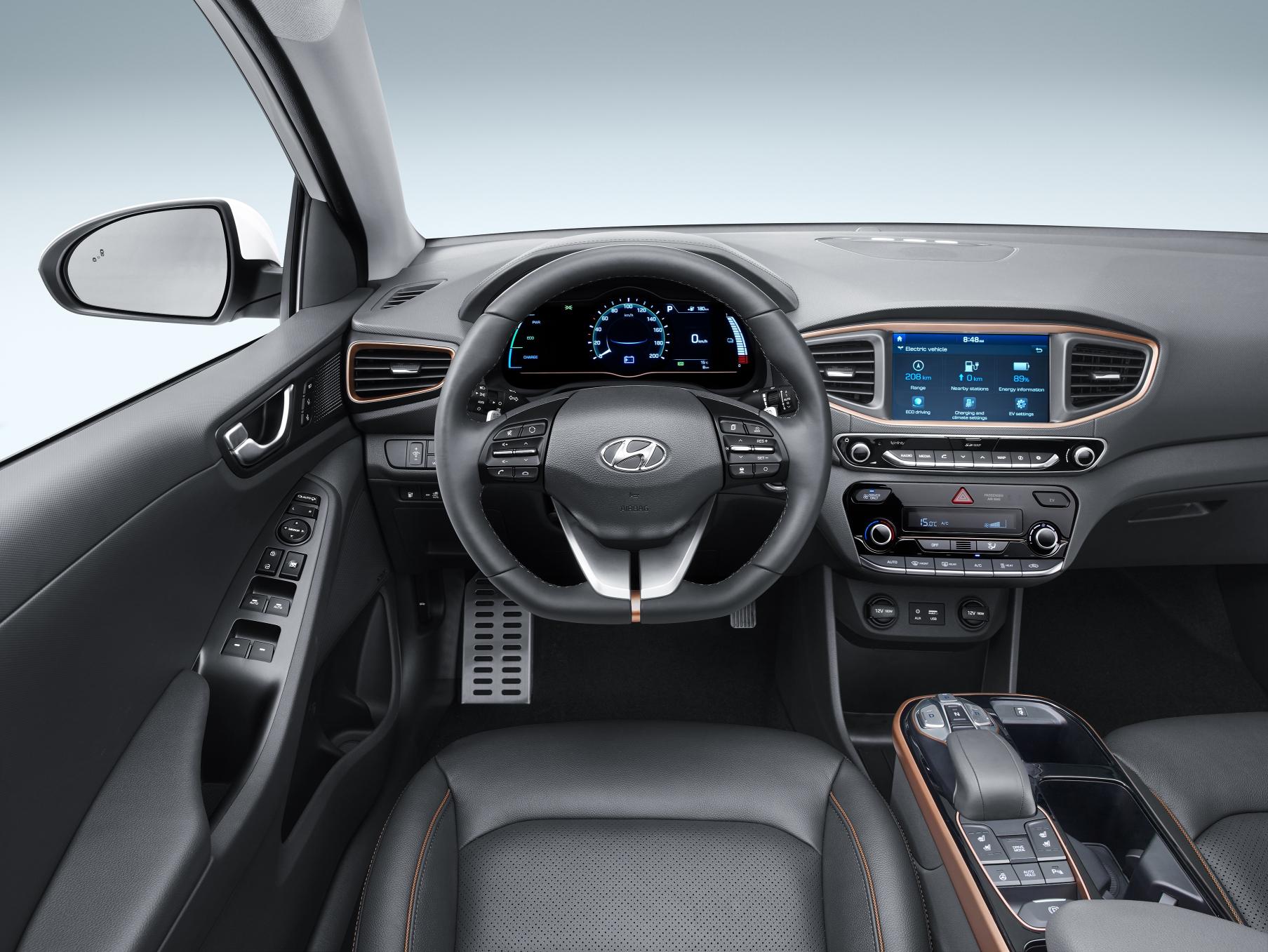
Interior design
Just as with the car’s exterior design, the interior of the IONIQ captures the model’s futuristic perspective. A ‘Purified High-Tech’ concept was established, which then evolved into the refined interior of the IONIQ.
A smooth, elegant and clutter-free theme works with a logical, structured layout of controls. Materials for the interior were chosen in an ecologically sensitive way and are used to create a simple and clean look throughout the car, giving the inside space a sleek, light and purified feel.
Exclusive blue colour code
The blue character line exclusively available for the IONIQ Hybrid and the IONIQ Plug-in is carried on in the interior featuring blue piping on the seats and further blue design elements on the fascia. These include a blue metallic line running below the digital instrument cluster and between the air conditioning control knobs, surrounding the centre console air vents, the audio navigation screen and outside air vents as well as the starter button. Another accent is on the lower part of the steering wheel. The interior is available in two colours a darker grey tone called Lava Stone and a light beige called Afternoon Breeze.
Copper symbolizes electricity
Inside the IONIQ Electric exclusively available copper coloured accents create the impression that electricity is flowing through the whole car’s interior. Passengers of the Electric will also notice that there is more space between the front seats. This has been achieved thanks to the shift by wire system that doesn’t have mechanical linkages between a shifter and the transmission and so allows the driver to switch drive modes simply by pressing the right buttons in front of the palm rest. The IONIQ Electric also features an electronic parking brake (EPB) at the command of the driver’s fingertips and the inductive charging tray for mobile phones is conveniently positioned right next to the shift by wire buttons.
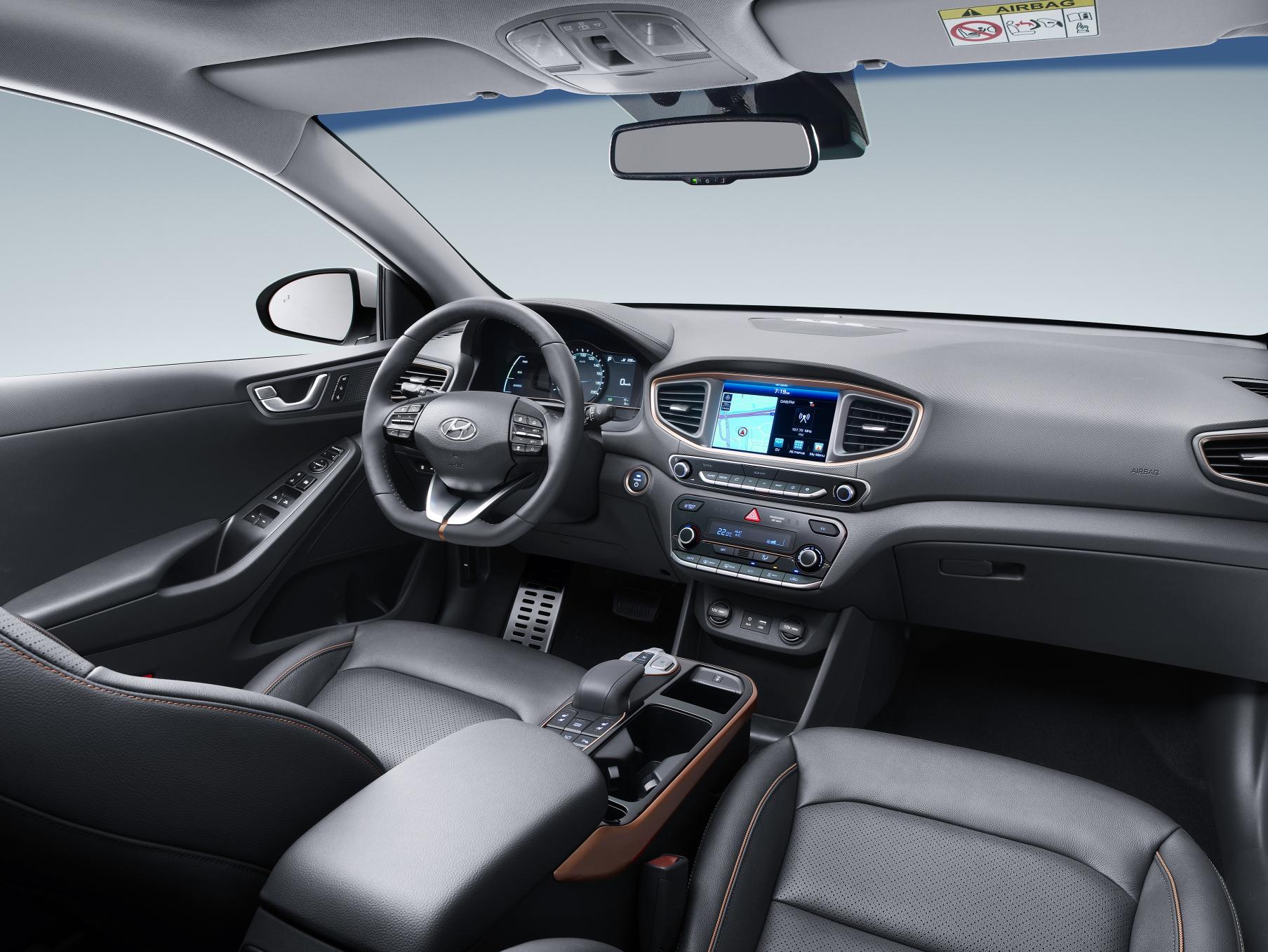
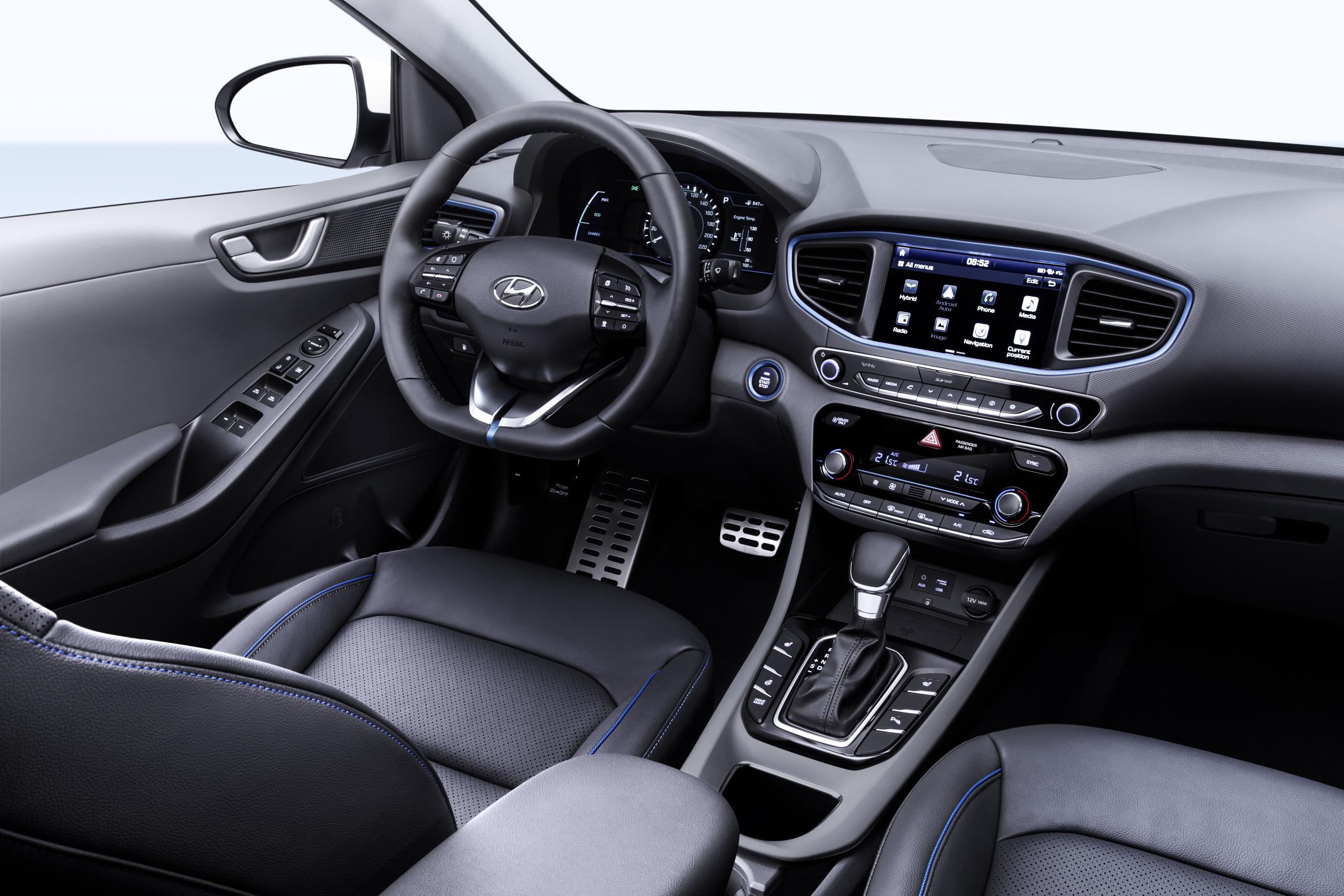

02 Powertrains – the power of choice for customers
Developed for energy efficiency without compromising driving performance, every IONIQ’s powertrain option represents a cleaner way of mobility.
Breaking through hybrid stereotypes with IONIQ Hybrid & Plug-in
The IONIQ Hybrid and IONIQ Plug-in both feature the new Kappa 1.6 GDI, direct injection petrol, four-cylinder engine with a class-leading thermal efficiency of 40 per cent delivering 105 PS and 147 Nm of torque. The engine has been tailored to the hybrid application and is combined with the direct responding, smooth shifting six-speed double clutch transmission – differentiating the IONIQ from its competitors with a more dynamic driving experience. The mated electric motor enables pure electric driving and delivers instant torque as the chassis with rear multi-link suspension greatly enhances driving dynamics.
The IONIQ Hybrid’s electric motor delivers 32 kW (43.5 PS) with maximum torque of 170 Nm, powered by a lithium-ion-polymer battery with 1.56 kWh capacity positioned under the rear seats. In combination with the 1.6-GDI engine IONIQ Hybrid offers a system output of 103.6 kW (141 PS) rpm and up to 265 Nm of torque accelerating to a top speed of up to 185 km/h with targeted CO2 emissions as low as 79 g/km (combined). The electric motor enables the IONIQ Hybrid to operate in pure electric mode at speeds up to 120 km/h.
Drivers choosing the IONIQ Plug-in can safely rely on over 50 kilometres of estimated pure electric driving range powered by the potent 8.9 kWh lithium-ion polymer battery. The 45kW (61 PS) electric motor together with the 1.6 GDI four-cylinder Kappa engine offer a system which targets CO2 emissions as low as 32 g/km.
Six-speed dual-clutch transmission – responsiveness guaranteed
The IONIQ Hybrid and IONIQ Plug-in both feature a six-speed dual-clutch transmission (6DCT), which boasts best-in-class transfer efficiency though the use of low-friction bearings and low-viscosity transmission oil. This ensures that IONIQ achieves a unique mix of driving performance and fuel efficiency. Intelligently set gear ratios combined with a clever shift strategy transfer power smoothly from gear to gear.
Both, the Hybrid and the Plug-in, use the 6DCT to harness the electric and combustion technologies to best effect, for a more engaging drive. That is how they differentiate themselves from other hybrid and plug-in hybrid cars, which are often criticized for ‘rubber band-like’ acceleration.
Enhancing the car’s fuel efficiency and dynamic driving characteristics, the driver can select SPORT or ECO modes. The SPORT function holds lower gears longer and combines power from the engine and electric motor maximizes performance. In ECO mode, the 6DCT optimizes the gear selection for fuel economy, shifting up earlier to higher gears to achieve class-leading fuel economy.
The powertrain components were designed to be compact and highly efficient. The combined extra weight of the hybrid and plug-in hybrid technology therefore only adds minimal weight to the IONIQ.
Compact electric motor powered by lithium-ion polymer battery
Electric power for the Hybrid and the Plug-in as well as for the Electric is generated by a permanent magnet synchronous motor. The parts of which have been optimized by reducing the thickness of core components (electrical steel sheet) by up to 10% and adopting rectangular-section copper wire to decrease core and copper loss.
Hyundai Motor decided to use a lithium-ion polymer battery pack for all IONIQ models instead of conventional nickel-metal-hydride batteries. This provides lower memory sensitivity, excellent charge and discharge efficiency along with outstanding maximum output.
Efficient packaging was also taken into consideration as the battery system is located underneath the rear seats so that the usability of the passenger cabin and cargo area is entirely uncompromised in the IONIQ Hybrid, offering cargo space of up to 750 litres. This also holds true for the IONIQ Plug-in and the IONIQ Electric which despite larger batteries both offer generous cargo capacity of up to 650 litres.
An all-electric all-star
The IONIQ Electric offers pure e-mobility through a 28 kWh lithium-ion polymer battery for an estimated range of over 250 km. The instantly available maximum torque of 295 Nm is delivered by the electric motor with a maximum output of 88 kW (120 PS) through the single-speed reducer transmission accelerating the car up to 165 km/h.
The shift by wire system unique to IONIQ Electric enables operation of the car simply by pressing buttons to switch driving modes. Plus it eliminates the routing space required for housing the mechanical linkages between a normal shifter and the transmission, providing more space in the front of the car. The Single Speed Reducer transmission automatically and seamlessly accelerates the Electric and offers SPORT, NORMAL and ECO modes to enhance efficiency and driving characteristics.
Charging the IONIQ Electric’s lithium-ion polymer battery up to 80% only takes 24 minutes using a 100kW fast charger. An integrated In-Cable Control Box (ICCB) also allows drivers to charge their IONIQ at a regular household socket. The charging plug of the car is located in a position where gas fillers are normally located..
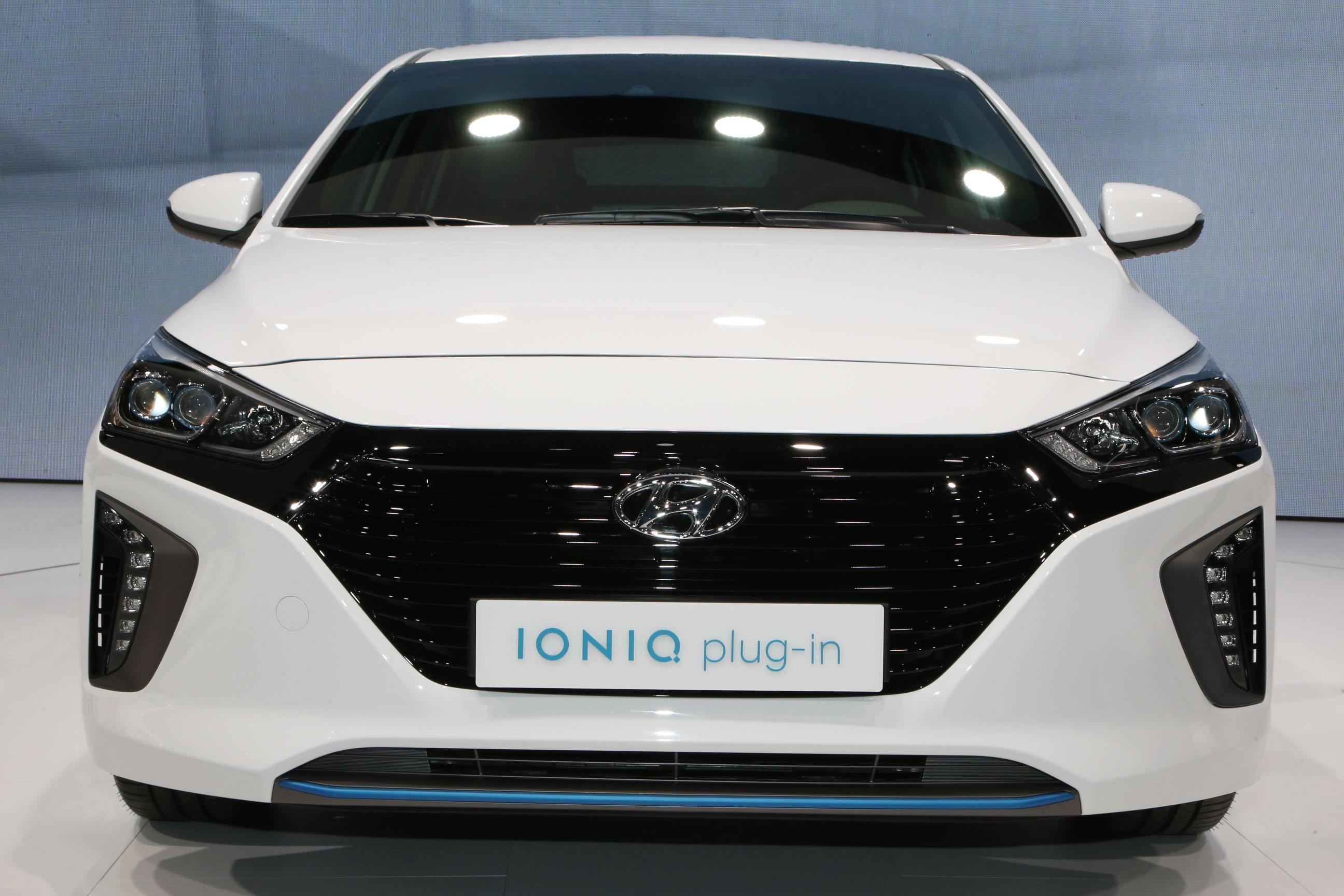
03 Advanced engineering and technology – Setting the IONIQ line-up apart
IONIQ’s engineers did not only focus on making the powertrain of each model as efficient as possible, they also set out to create cars that excelled in design, comfort and convenience of infotainment. Applying the latest technologies and engineering techniques to these areas enhances IONIQ’s appeal and elevates its status.
Advanced aerodynamics
IONIQ’s sleek, coupe-like silhouette and its simple, carefully wrought contours assist the efficient management of airflow around the exterior. Applications like front wheel air curtains, a rear spoiler and diffuser, side sill moldings, floor undercover and a closed wheel design all contribute to the car’s high aerodynamic efficiency. Additionally the Hybrid and Plug-in feature an active air flap in the front grille operated in three stages, while a sleek closed front characterizes the Electric.
Smart and efficient air condition
To provide a pleasant, comfortable and refreshing climate in the cars without using unnecessary amounts of energy, the IONIQ’s climate control can be switched to an efficient operation mode. Due to a maximum utilization of the inside air when air-conditioning or heating, ventilation losses can be minimized and the overall efficiency of the system increases. Also, the dual-zone climate control can be set to ‘driver only’ mode, reducing the load of the air-conditioning and heating.
Eco materials create clean and sustainable interior space
A Hyundai-first and a key characteristic of the IONIQ is its innovative use of recycled or ecologically sensitive materials. For example, the interior door covers are made of recycled plastic combined with powdered wood and volcanic stone while providing the same quality appearance.
The softer, more natural feel is achieved alongside less reliance on oil-based products. This approach extends to other areas of the car too. Raw materials extracted from sugar cane are partly applied on the headlining and carpet helping to improve quality of air inside the car and the recyclability of vehicle parts at end of life. Paint with renewable ingredients extracted from soybean oil is used to achieve lustrous metallic colours on some of the components.
The new navigation system in the IONIQ comes with a seven-year free subscription to TomTom LIVE services. TomTom LIVE offers updated information in real time: weather, traffic, speed cameras, and online searches for points of interest.
Infotainment
To suit customers’ varied lifestyles, IONIQ features state-of-the-art infotainment and connectivity features. The IONIQ is equipped with a new generation high-resolution 7-inch TFT information cluster. With a resolution of 1280 x 720 pixels, it displays all types of gauges (speedometer, ECO, state of charge, fuel etc.) Depending on the selected drive mode, background colour and gauges are adapted to always provide the most important and useful information as well as a relaxed or sporty atmosphere by means of the colours used. Within SPORT mode, the display changes into a revolving digital speedometer that is surrounded by an analogue style tachometer, showing the engine’s rpm on red coloured ground. When choosing ECO mode the TFT-information cluster simulates the familiar speedometer needle.
The IONIQ will also cater for drivers looking to integrate their smartphone with the vehicle’s infotainment system by providing both Apple CarPlay and Android Auto. Both systems enable users to connect their devices to deliver and control music, telephone or navigation functions on screen. The seamless connectivity allows drivers and passengers to stay connected while remaining focused on the road. To ensure occupants’ phones are always charged, IONIQ also offers a wireless inductive charging pad (Qi standard) for mobile phones.

Weight reduction
One of the main questions throughout the development of IONIQ was where weight could be cut without compromising the goal to also create an engaging and comfortable car. IONIQ’s engineers used aluminium in the hood and tailgate, which reduces weight by 12.4 kg compared to the conventional steel option with no disadvantages in noise or vibration. The weight loss strategy also extended to less obvious areas like the cargo-screen cover. Due to a higher usage of lightweight components and a more compact build, the cargo-screen cover is around 25% lighter than the version used in other Hyundai models.
04 Driving performance – Low to zero emission mobility without compromise
The driving performance of the IONIQ line-up is among the best in its segment thanks to a powertrain which is specially adapted to deliver efficient mobility without compromise. Ride and handling, as well as noise, vibration and harshness levels, are tuned to contribute towards superior ride quality, while insulation in the dashboard minimizes engine noise. Damping in the floor panels as well as enhanced A and B pillar fillings, thicker window glass and noise cancelling film on the windshield further improve the quiet and comfortable ride.
The IONIQ Hybrid and Plug-in feature a multi-link rear suspension system with dual lower arm for enhanced ride comfort while a proportionately large use of aluminium for front and rear suspension components saves around 10 kg of weight compared to conventional means. A reduction of 2.3 kg per front lower arm unit saves 4.6 kg at the front, while 7.14 kg is saved at the rear with each unit shedding 3.57 kg.
The IONIQ Electric applies a torsion beam rear axle which provides more space for the 28 kWh lithium-ion polymer battery, placed below the rear seats and the spare wheel well..
IONIQ’s responsiveness and feedback from the steering system is clear and precise, with an increased steering gear ratio that helps to compound a sporty and responsive feel while reinforcing the car’s uncompromised driving experience.
Braking force is optimized to get the most out of the regenerative braking system, helping the IONIQ to maintain a healthy state of charge (SOC). Regenerative braking also operates to reduce noise, using the third generation of the brand’s energy recuperating stopping system. An Integrated Brake Assist Unit (iBAU) and Pressure Source Unit (PSU) also contribute to quieter operation than competitors. This also helps ensure ultra-low friction for maximum energy recuperation and efficiency.
A collaboration with tire manufacturer Michelin gives IONIQ enhanced levels of efficiency as the car is fitted with low rolling resistance tires from 15-, 16- and 17-inch wheels for better fuel economy, plus the car’s larger 17-inch wheels (IONIQ Hybrid) are fitted with silica tires for better performance. The multi-link suspension system of IONIQ Hybrid and Plug-in has been adapted in order to work most efficiently with low rolling resistance tires.
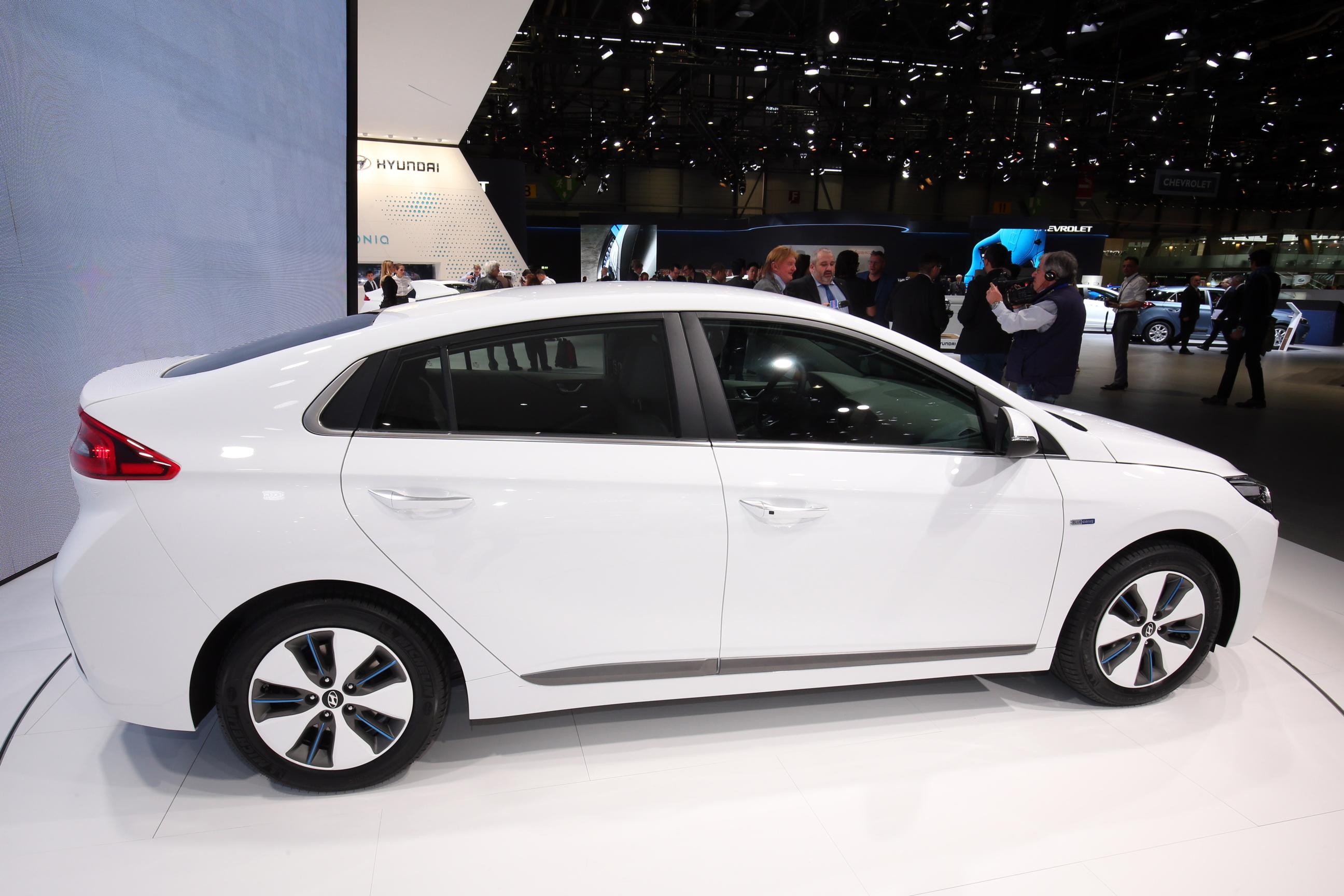

05 Comfort and convenience – top-class and trend-setting
Thanks to its dedicated design the IONIQ line-up delivers great driver and passenger convenience, bringing to the segment a range of considerations that other hybrid, plug-in hybrid and electric vehicles may have compromised on in the past.
So for example all hybrid components are cleverly packaged to not compromise space, flexibility or usability of the interior. In fact, the IONIQ Hybrid offers best-in-class cargo space by positioning the battery underneath the rear seats. Moreover, the rear seats can fold flat providing a cargo space of up to 750 litres, allowing large pieces of luggage to be stowed with ease.
All IONIQ models also offer great front and rear headroom, plus comprehensive shoulder and leg room in the front and back, while a memory function driver’s seat and heated front and rear seats invite occupants for a relaxing ride.
06 Safety – innovative active and passive safety features
A light yet rigid body is the result of advanced design, construction methods and materials for the entire IONIQ line-up. Featuring 53% Advanced High Strength Steel, the chassis of the cars benefits from superior rigidity for responsive handling and is extremely safe, with high impact energy absorption and minimized distortion to protect passengers in the event of a collision.
To complement the long list of advanced convenience technologies, a host of innovative active and passive safety features protect the driver and passengers. These electronic assistive systems are class-leading as the IONIQ continues to break the mould for alternative fuel vehicles.
The long list of active safety features includes Blind Spot Detection, which works directly alongside Lane Change Assist and Blind Spot Detection with Rear Cross Traffic Alert to warn the driver of any surrounding vehicles, passengers or other objects that may lead to a collision if unnoticed while the car is in motion.
A Lane Departure Warning System (LDWS) and Lane Keeping Assist System (LKAS) are of use when driving. The systems alert the driver if unsafe movements are made while the car is driving over 60km/h by sensing the car’s position. The LDWS sounds an alarm before the car moves over the road markings, while the LKAS warns the driver acoustically and visually before inducing corrective steering to guide the driver back to a safe position.
The IONIQ is also fitted with Autonomous Emergency Braking (AEB), an advanced active safety feature that alerts drivers to emergency situations, braking autonomously if required. Using front radar and camera sensors, AEB operates in three stages. Initially warning the driver visually and acoustically, it controls the brake according to the collision danger stage, and applies maximum braking force right before the moment of collision. When a vehicle or pedestrian is sensed in front of the car, the system is activated, operating at speeds of 10 km/h or above and minimizes damage when a collision is unavoidable.
Using front radar sensors, Smart Cruise Control allows a constant speed and distance to be maintained from the vehicle ahead without depressing the accelerator or brake pedals; it is automatically cancelled when speed drops to 10 km/h or below. IONIQ Electric enhances this functionality with an Advanced Smart Cruise Control, which also supports automatic stop and start function. A Tyre Pressure Monitoring System ensures constant monitoring of tyre pressure and alerts the driver if pressure levels have changed.
Around the interior of the IONIQ, a total of seven airbags is available. Including a knee airbag for the driver, they are placed to protect the vehicle’s occupants in the event of a collision. Body structure improvements complemented by a high-strength fibre-reinforced rear bumper make the entire IONIQ line-up strong and durable in the event of a crash.
All technical specifications and emission values are preliminary target values and subject to homologation.
[PLEASE NOTE – Specification may vary by market / region]
HYUNDAI MOTOR INTRODUCES PROJECT IONIQ AT THE GENEVA MOTOR SHOW 2016
- Hyundai Motor aims to create new lifestyles for the future through long-term research and development activities on innovative products and services
- Project IONIQ aims to achieve ‘freedom in mobility’ by providing smart, effortless ways to move and live
High Wycombe, 1 March 2016 – Hyundai Motor today announced Project IONIQ, a long-term research and development project that will redefine future mobility through innovation, enhancing the lives of Hyundai customers and wider society. The beginning of the project starts with the unveiling of the IONIQ model, which is the first car to offer the choice of three alternative-fuel powertrains.
“The future mobility lifestyles that we envisage is about staying connected to our daily lives all the time without being bound by the limitations of time and space,” said Euisun Chung, Vice Chairman of Hyundai Motor. “We are determined to make this a reality so that everyone can enjoy better, more fulfilling lives,” added Chung.
Through Project IONIQ, Hyundai Motor will bring ‘freedom in mobility’ with the four key directions – freedom to effortlessly access mobility whenever and wherever, freedom to connect everyday life while on the move, freedom from accidents and inconveniences and freedom from environmental pollution and energy exhaustion.
The three main research areas of Project IONIQ are about predicting changes in future mobility and studying possible scenarios, developing new types of mobility according to changes in society and people’s lifestyles and creating new service models and mobility experiences that extend the role and definition of ‘cars’.
As the first step of Project IONIQ, Hyundai Motor introduced the new alternative-fuel IONIQ model, the world’s first car to offer a choice of three electrified powertrains at the Motor Show.
“We will continue to make technological strides in various areas to bring freedom and convenience in mobility for our customers with ever-improved mobility,” said Woong-chul Yang, Vice Chairman and Head of Hyundai R&D Center.
Hyundai Motor plans to find ways with Project IONIQ to converge different technologies and suggest new mobility concepts and services that help meet the changing needs and expectations of society.
